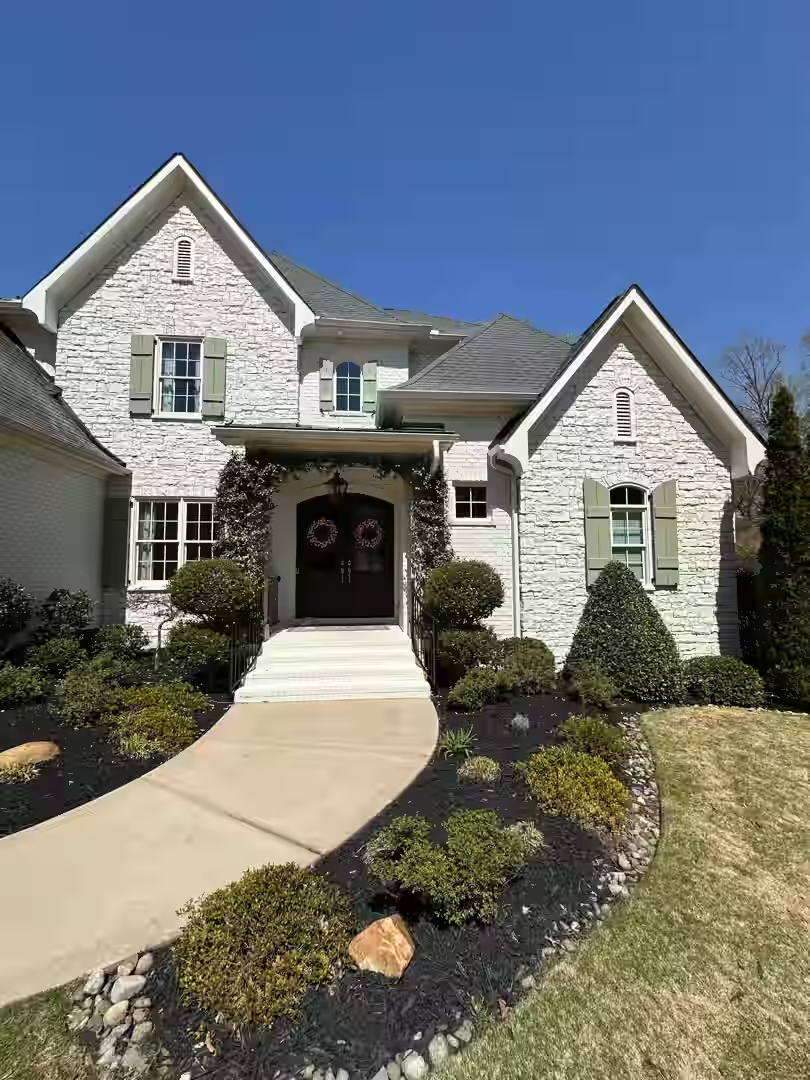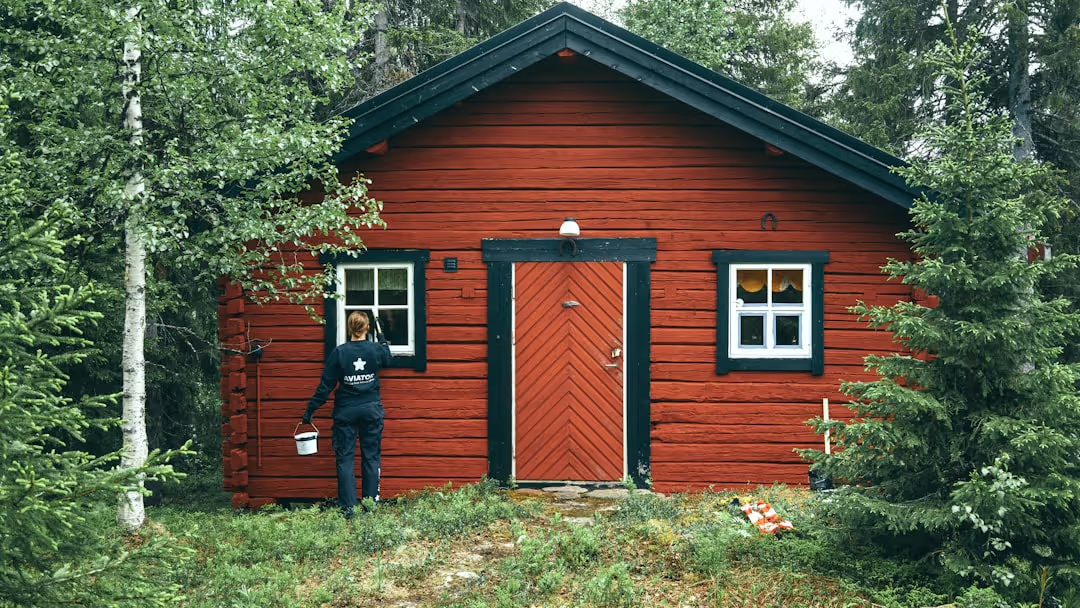Decoding the Dollars: A Realistic Look at Interior Painting Costs Per Room
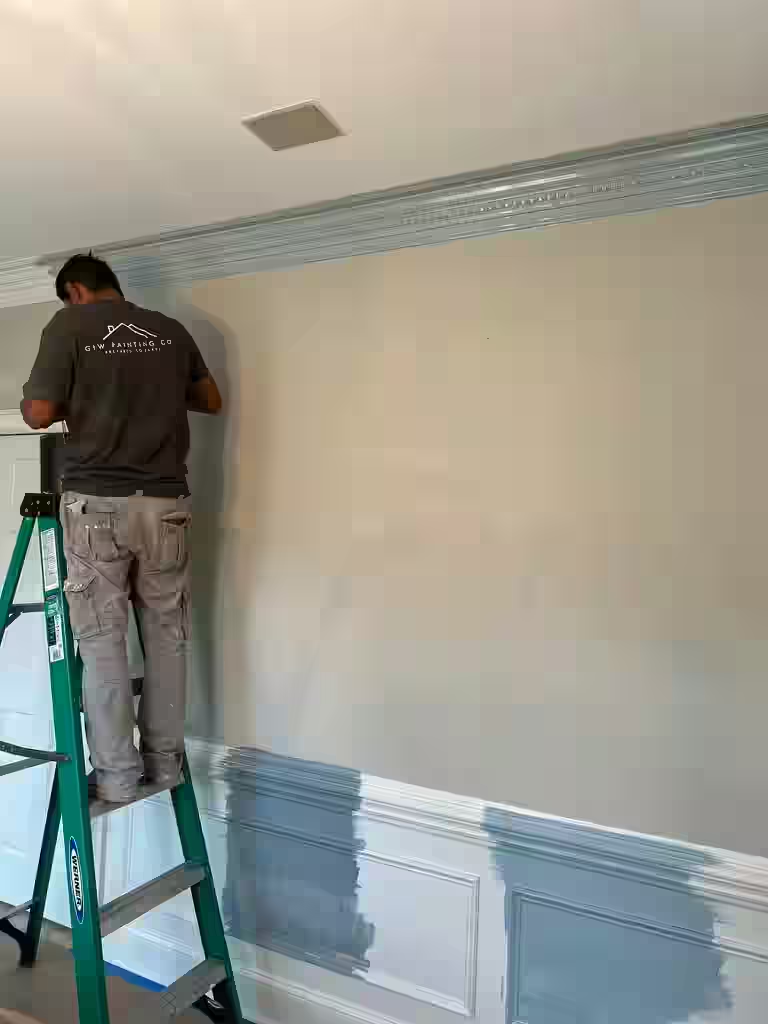
Understanding What You'll Really Pay to Paint Your Home
Paint cost per room is a top question for homeowners planning an interior refresh. While there's no single price tag, understanding the key variables will help you budget confidently.
Quick Answer: What Influences Your Room Painting Cost
- Room Size: A small bedroom costs less than a large living room.
- Scope of Work: Walls only vs. walls, trim, and ceilings.
- Wall Condition: Smooth, ready walls vs. walls needing repair.
- Paint Quality: Budget paint vs. premium, durable finishes.
- Geographic Location: Labor rates vary by region.
According to industry surveys, the average project can range from a few hundred dollars for a small bathroom to over a thousand for a large living room with high ceilings and detailed trim. This variation comes from the project's size, scope, wall condition, and material quality—not just the color you choose.
As Charlotte homeowners ourselves, we know the frustration of vague pricing. You deserve to know what drives the cost of painting a room to avoid surprises. The cost of our painting services varies, which is why we offer free estimates to provide an accurate quote for your specific needs.
In this guide, we'll break down every factor that influences your paint cost per room, so you can make informed decisions about your home's change.
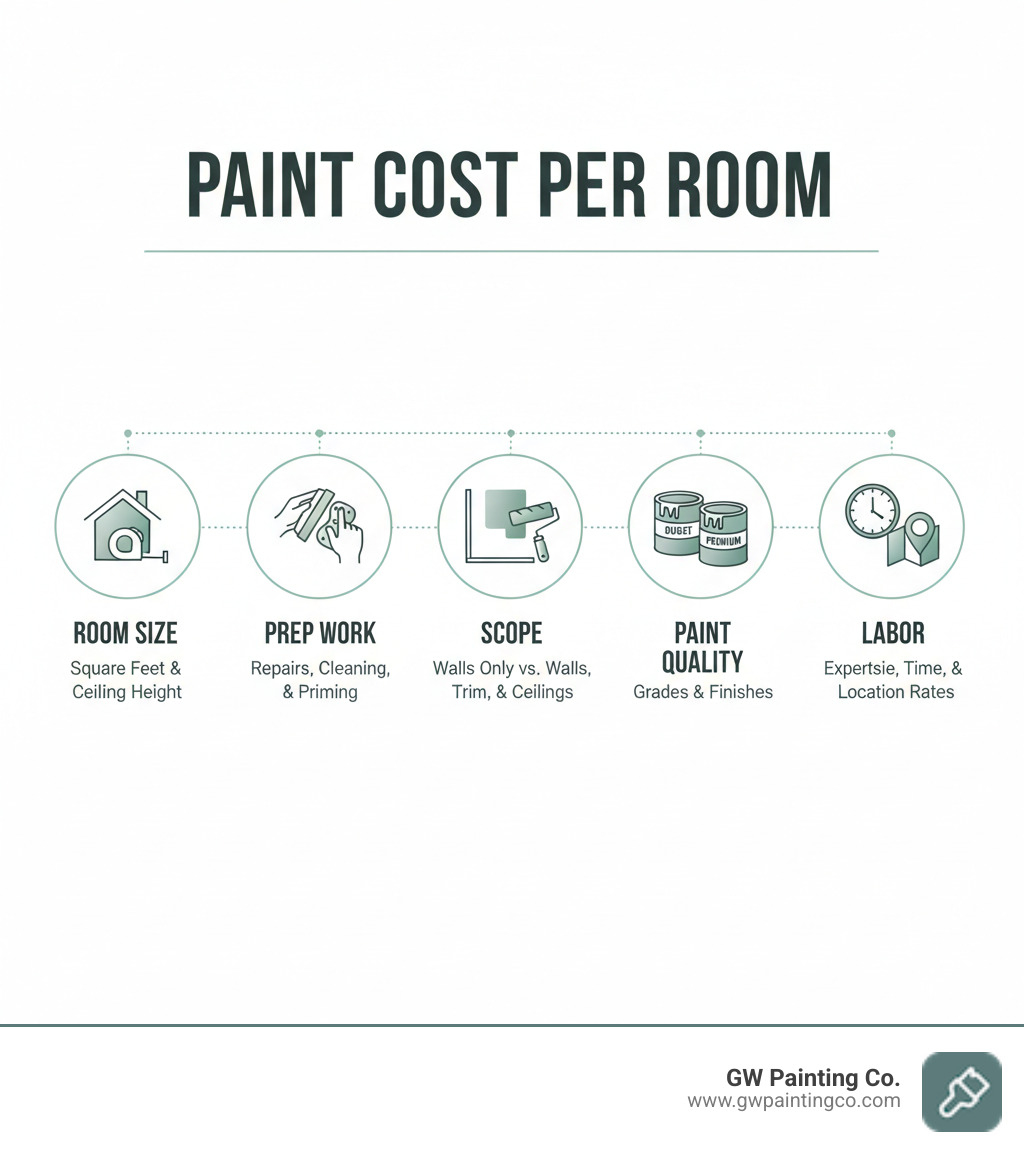
The Key Factors That Determine Your Paint Cost Per Room
While choosing the perfect color is exciting, your final paint cost per room depends on a combination of factors. After years of painting homes in the Charlotte area, we know that two rooms of the same size can have vastly different costs.
The main drivers behind your investment are labor, project scope, material quality, and the prep work your walls need. Let's walk through each factor so you know exactly what you're paying for.
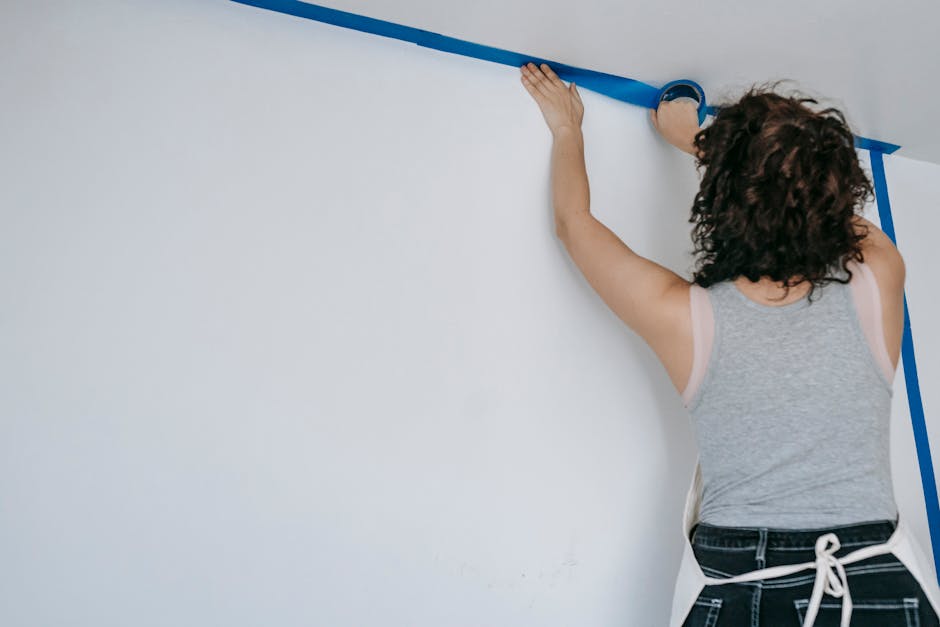
Room Size and Layout: More Than Just Square Feet
While larger rooms cost more, it's not just about floor measurements.
- Square Footage: The total wall surface area is the foundation of any estimate. A 10x12 bedroom requires less paint and labor than a 20x25 living room.
- Ceiling Height: Standard 8-foot ceilings are the baseline. Vaulted ceilings, two-story entryways, or walls over 12 feet high require more surface area, specialized equipment like scaffolding, and extra time.
- Room Complexity: A simple, rectangular room is straightforward. A room with built-in bookshelves, multiple windows, or archways requires more careful cutting-in and taping, which adds to the labor involved.
The Scope of Work: Walls, Trim, and Ceilings
What exactly do you want painted? Your answer significantly impacts the cost.
- Walls Only: This is the most budget-friendly option, giving your room a fresh look by focusing only on the main wall surfaces.
- Full Room Change: Painting walls, trim, and ceilings offers a complete refresh. This is more comprehensive and time-consuming but yields a totally renewed space.
- Trim, Doors, and Ceilings: These elements require precision. Painting trim, baseboards, doors, and windows involves meticulous taping and brushwork. Ceilings are physically demanding and may need special paint, especially if textured. Including these in your scope increases the investment but creates a polished, professional look. You can see our attention to intricate work in projects like our Custom Interior Painting & Trim Molding.
The Unseen Cost: Wall Condition and Prep Work
What happens before the first coat of paint is often the biggest cost factor. Proper prep is the foundation of a lasting finish.
- Minor Imperfections: Small nail holes, scuffs, and dings are standard repairs we handle to ensure a smooth surface.
- Extensive Drywall Repair: Large holes, cracks, or water damage require significant patching, sanding, and priming, adding considerable time and materials.
- Wallpaper Removal: This time-consuming process often reveals damaged walls underneath that also need repair.
- Surface Cleaning: Paint won't adhere to dirty surfaces. Walls in kitchens and bathrooms may need heavy-duty cleaning to remove grease and grime, adding to prep time.
Choosing Your Finish: How Paint Quality and Sheen Affect Price
Not all paint is created equal. The type and quality you choose directly influence cost and longevity.
- Paint Quality: Premium paints offer better coverage, durability, and richer color. While they cost more per gallon, they often save money by requiring fewer coats and lasting longer.
- Primer: This is essential for covering stains, painting new drywall, or making dramatic color changes. It ensures uniform coverage and helps you use less topcoat paint.
- Sheen: The finish affects both look and durability. Flat/matte finishes hide imperfections well and are affordable. Eggshell/satin offer a slight sheen and better washability. Semi-gloss/high-gloss are highly durable and easy to clean, making them ideal (and more expensive) for trim, doors, and high-traffic areas. The Painting Contractors Association offers helpful resources on paint types.
Beyond the Basics: Additional Services That Impact Cost
Extra touches can lift your space but will affect your investment.
- Furniture Moving: Extensive furniture relocation or disassembly adds labor time.
- Accent Walls: These require precise taping and often extra coats, especially with bold colors.
- Textured Surfaces: Applying or removing textures like popcorn ceilings requires specialized techniques, materials, and significant labor.
- Special Finishes: Artistic effects like color washing or ombre are highly labor-intensive and are considered premium services.
Why Costs Vary: A Room-by-Room Breakdown
Not all rooms are created equal—at least not when it comes to painting them. The paint cost per room can swing dramatically depending on which space you're refreshing. A simple bedroom is straightforward, but a kitchen with numerous cabinets is a different story. A room's function dictates the paint type, durability requirements, and labor involved. Let's explore why each space has unique costs.
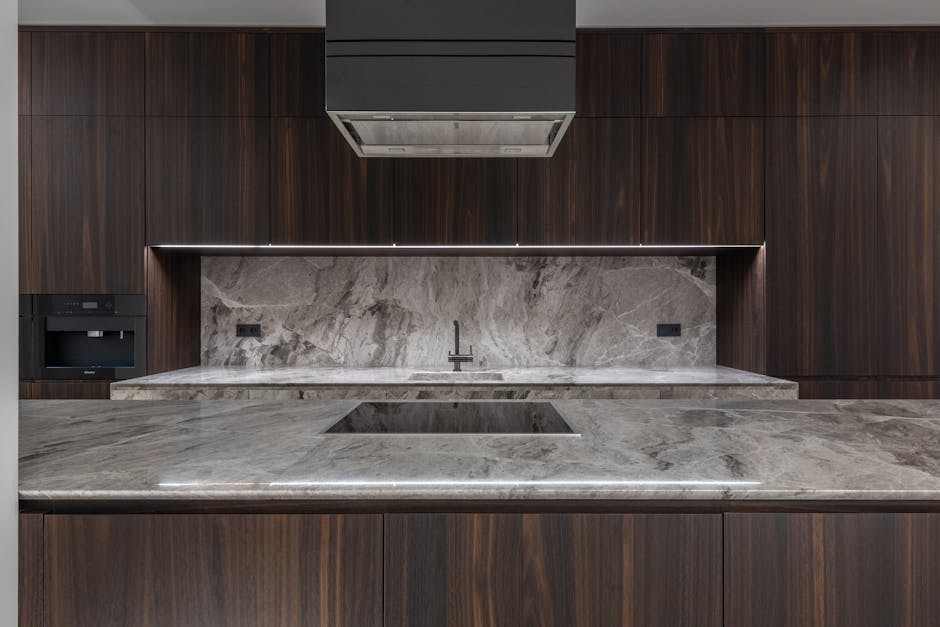
Living Rooms & Bedrooms: The Standard for Your Paint Cost Per Room
These spaces typically set the baseline for painting costs. They usually feature standard surfaces like flat walls with a reasonable number of windows and doors. The main cost variable is size; a large, open-concept living room with vaulted ceilings will cost more than a small 12x12 bedroom due to the increased surface area and labor. Since these are lower-traffic, dry areas, you have more freedom in choosing finishes, though quality paint is always recommended for better coverage and durability.
Kitchens & Bathrooms: The Challenge of Moisture and Complexity
Kitchens and bathrooms are often the most investment-intensive rooms to paint for two key reasons:
- Moisture and Durability: These rooms require specialized, moisture-resistant paint to prevent mildew and deterioration from steam and humidity. They also need durable, washable finishes (like satin or semi-gloss) to stand up to grease, condensation, and frequent cleaning. These premium products cost more but are essential for longevity.
- Complexity: The biggest time investment is cutting around cabinets, fixtures, and appliances. Unlike a simple wall, kitchens and bathrooms are full of obstacles—cabinets, backsplashes, sinks, toilets, and mirrors—that require meticulous taping and brushwork, increasing labor time. If you're updating your kitchen, our Cabinet Painting Project service can also transform the space.
Hallways, Foyers, & Basements: Durability for Unique Spaces
These transitional spaces have their own challenges that influence cost.
- Hallways and Foyers: As high-traffic areas, they need high-durability, scuff-resistant paint to withstand bumps and scrapes. Foyers with soaring ceilings or complex angles also require specialized equipment and more labor.
- Basements: Moisture resistance is key in damp-prone basements. Unfinished concrete walls require different prep and materials than standard drywall. Painting around exposed pipes and ductwork also adds to the complexity.
DIY vs. Hiring a Professional Painter
When you're planning a painting project, one of the biggest decisions you'll face is whether to roll up your sleeves and do it yourself or bring in professionals like our team. While DIY seems cheaper, the true paint cost per room involves more than just paint.
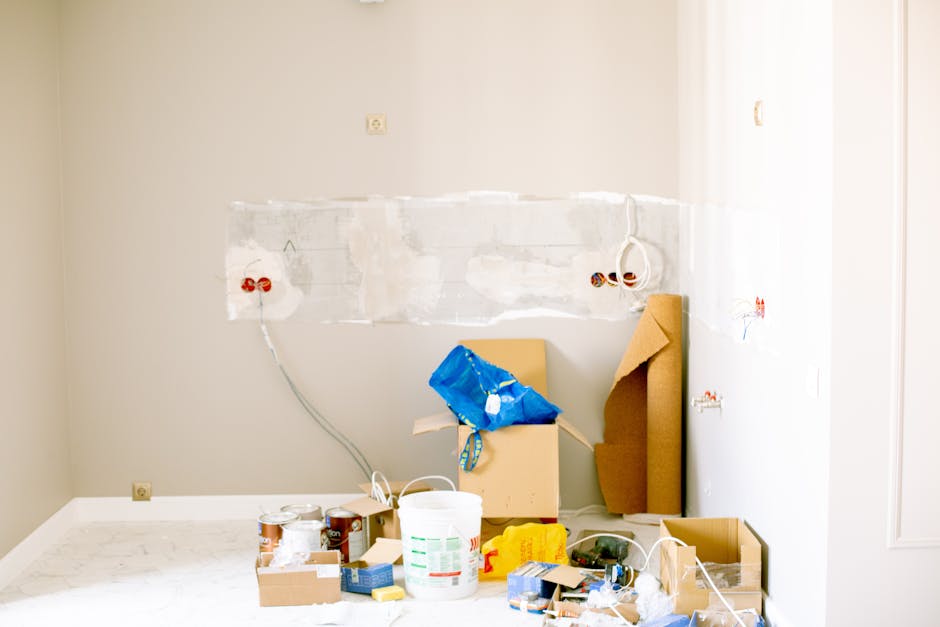
Calculating the DIY Cost: More Than Just a Few Gallons of Paint
The true cost of a DIY project includes more than just paint. Consider these expenses:
- Materials & Equipment: Primer, tape, drop cloths, patching compound, sandpaper, quality brushes, rollers, and ladders can add up to several hundred dollars.
- Your Time: Proper painting, including prep and multiple coats, can consume an entire weekend or more. Your time has value.
- Risk of Mistakes: Without experience, you risk drips, uneven coverage, and sloppy edges. Mistakes can mean redoing the work and buying more materials.
- Cleanup: Properly cleaning tools and your workspace is time-consuming and messy.
The Professional Advantage: Why Hiring a Pro is a Great Value
Hiring an experienced professional is an investment in expertise, efficiency, and peace of mind.
- Expertise and Efficiency: We know how to prep surfaces and achieve a flawless finish efficiently, completing projects in days, not weeks. Our results speak for themselves.
- Quality Materials: We have access to premium paints and supplies at contractor pricing, saving you from retail markups and costly trial-and-error.
- Proper Prep and Cleanup: We handle the most crucial and tedious parts of the job—thorough prep work and spotless cleanup. Our crews treat your home with respect.
- Satisfaction Guarantee: We stand behind our work. If something isn't right, we make it right. With DIY, you're stuck with the results, for better or worse.
When you factor in all the hidden costs, professional painting often delivers better value. You can learn more about what sets us apart by exploring our insights on Residential Painters Charlotte NC.
Frequently Asked Questions About Room Painting Costs
We understand you have questions about your investment. Here are clear, honest answers to common inquiries we receive about paint cost per room.
How can I get an accurate estimate for my paint cost per room?
Online "per room" quotes are rarely accurate because every project is unique. The only way to get a precise estimate is with a free, on-site evaluation. An experienced team member will visit your home to measure the space, assess wall conditions, and discuss your goals.
Afterward, we provide a detailed, written quote with a full breakdown of costs—labor, materials, and prep work. There are no hidden fees. We're committed to providing an accurate quote custom to your home, so be cautious of any flat-rate estimates given without an in-person assessment. For more insights into our process, visit our FAQs page.
How many coats of paint does a room usually need?
Two coats of paint are the standard for a professional finish. The first coat provides the base color, and the second ensures even, deep coverage. However, certain situations may require more:
- Primer: We use primer first when painting new drywall, covering stains, or making a dramatic color change. It creates a uniform base and improves adhesion.
- Drastic Color Changes: Going from a very dark to a very light color (or vice versa) may require three or more coats for full coverage.
- Paint Quality: High-quality paints have better "hide" (coverage), often achieving a perfect finish in two coats, while budget paints may need more.
Does choosing a dark paint color increase the cost?
Yes, it often does, but the result can be stunning. Dark colors typically require more coats to achieve a rich, uniform finish, which increases both material and labor costs. The pigments used in deep hues can also be more expensive. To offset this, we often use a tinted primer similar to the final color, which helps achieve full coverage with fewer topcoats. Working with dark colors also demands extra precision to ensure streak-free results and crisp lines, adding to the labor time. We'll always provide an honest assessment during your free estimate so you can plan accordingly.
Conclusion: Investing in a Quality, Lasting Finish
By now, you've gained a complete picture of what truly influences your paint cost per room. It's not just about slapping color on walls—it's about understanding the intricate dance between room size, the full scope of your project, the hidden prep work beneath the surface, and the quality of materials that will protect your investment for years to come.
We've walked through every room in your home together, from the straightforward beauty of bedrooms and living rooms to the moisture-challenged complexity of kitchens and bathrooms. We've explored why that hallway might need tougher paint than you expected, and why your foyer's soaring ceilings naturally require more investment. Each space has its own personality and demands, and your paint cost per room reflects that unique character.
The choice between DIY and professional painting isn't just about comparing dollar amounts on a receipt. It's about weighing your precious time, the frustration of potential mistakes, and the satisfaction of walking into a room with a flawless, lasting finish that you didn't have to stress over. When you work with experienced professionals like our team, you're not just buying paint and labor—you're investing in expertise, efficiency, and peace of mind.
A quality paint job does more than beautify your home. It protects your walls from daily wear, moisture, and the inevitable bumps of life. It improves your home's value and creates spaces where you genuinely love spending time. Most importantly, when done right with proper preparation and premium materials, it lasts—saving you from the headache and expense of frequent touch-ups or do-overs.
At GW Painting Co., we've built our reputation on delivering exactly this kind of lasting value to homeowners throughout Charlotte NC, Concord NC, Fort Mill SC, Indian Land SC, Gastonia NC, Matthews NC, and Waxhaw NC. Our licensed and insured crews treat your home with respect, work efficiently, and stand behind every project with our satisfaction guarantee. We believe you deserve transparency, quality craftsmanship, and a painting experience that's actually enjoyable.
The cost of our painting services varies depending on the size and scope of the project. We offer free estimates to provide you with an accurate quote custom to your specific needs. There's no pressure, no obligation—just an honest conversation about your vision and how we can bring it to life.
Ready to see your home transformed with colors that make you smile every time you walk through the door? Let's start that conversation today.
Get your free, detailed estimate for interior residential painting

.avif)
.avif)
